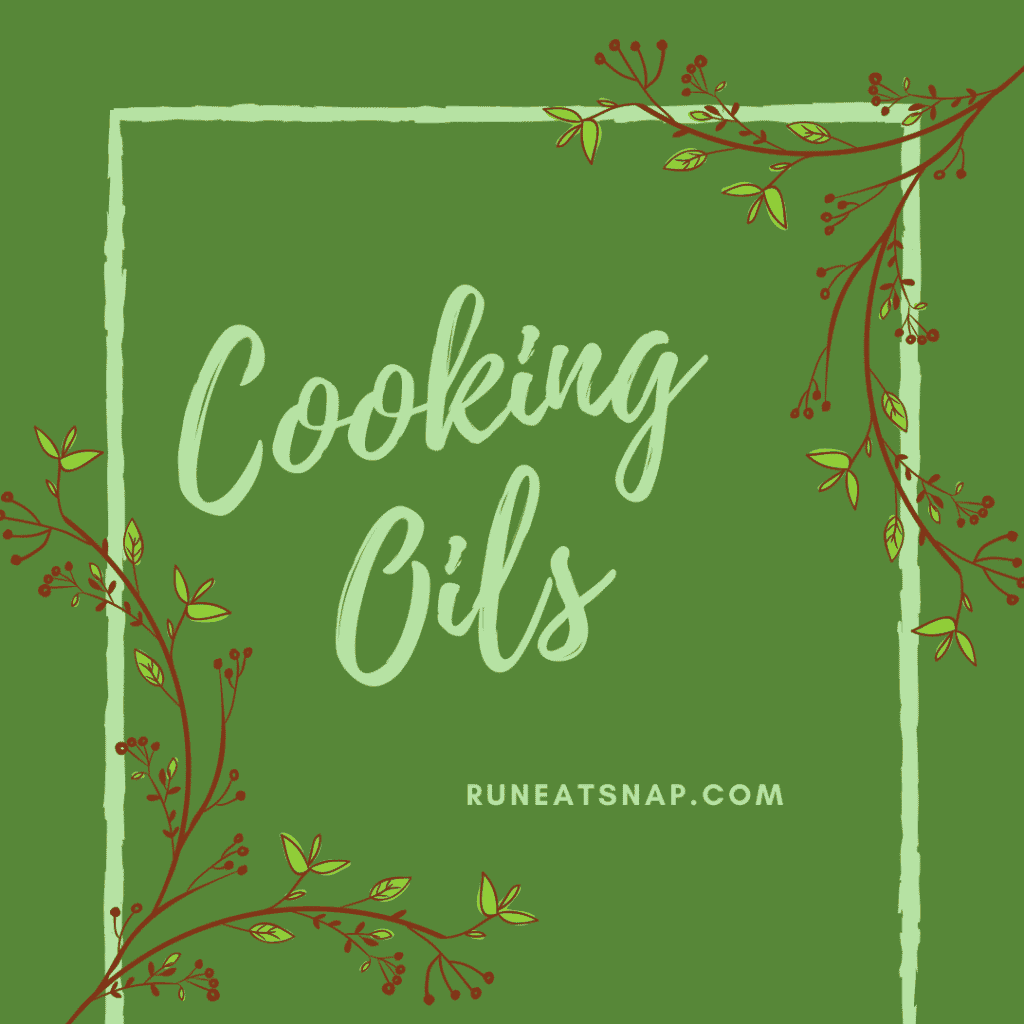Cooking oils are a source of dietary fat. This post outlines nutritional information of different oils, things to look for, uses of cooking oils, smoke points, and more.

Cooking Oils
Oils provide us with a dietary source of fat. They contain varying levels of saturated fats and unsaturated fats. If the oil contains more saturated fat, it will typically be more solid at room temperature, such as butter or coconut oil. If the oil contains more unsaturated fat, it will be more liquid at room temperature, such as olive oil or canola oil.
Saturated fat consumption should be limited to less than 10% of your total calories per day. It is associated with an increased risk of cardiovascular disease and may increase LDL cholesterol levels. Saturated fat is often found in animal products, but high amounts can also be found in some plant products such as coconut oil. Unsaturated fat, on the other hand, usually comes from plant sources and also from select fish such as salmon and tuna.
Unsaturated fat can further be categorized as monounsaturated and polyunsaturated fat. Eating more unsaturated fat may reduce your risk of cardiovascular disease and may improve HDL cholesterol levels. Replacing foods higher in saturated fats, such as baked goods and butter, with foods higher in unsaturated fat, such as vegetable oils, avocados, nuts and seeds, may improve your overall nutritional status.
Fats, such as oils, help with hormone production and allow your body to store the fat soluble vitamins A, D, E, and K. Oils, particularly those with unsaturated fats, provide Vitamin E, which serves as an antioxidant and protects the membranes of red blood cells, white blood cells, nerve cells, and lung cells. Vitamin E may also decrease total cholesterol.
Uses of Cooking Oils
Oils can be used for dressings, sauteing, frying, flavoring, and many other uses. First, understanding the fatty acid profile of each may be helpful. The figure below outlines the saturated and unsaturated fat composition of each.

Vegetable oils, such as olive, canola, and avocado, can be used for cooking and as salad dressings. Certain oils, such as cottonseed, soybean, and safflower, provide neutral flavor profiles; whereas, others provide unique flavors, such as olive oil and nut oils. Depending on your palate, certain oils may taste better. It is worth experimenting!
You may be wondering: what is the difference between extra virgin olive oil and regular olive oil? The process of making extra virgin does not use heat or chemicals to extract the oil out of the olives. The yield of the olives is lower which is why extra virgin is more expensive than regular, but the flavor is stronger.
Regular olive oil uses heat to extract the oil from the olives, which allows for a greater yield in production; therefore, it is cheaper. The quality is not as high as extra virgin, but consumers still benefit from the unsaturated fat profile of the oil.

Smoke Points of Cooking Oils
When sauteing or frying food, it is important to remember that oils have various smoke points. Smoke point is the temperature at which a fat breaks down into visible gaseous products. At the smoke point, fat creates free radicals that are harmful to the body and visible smoke will appear. Avoiding this is highly recommended.
The figure below indicates the smoke points for various fats. The higher the smoking point, the better the oil is for sauteing and frying. Canola is a common oil used.

There are some considerations to remember when sauteing or frying foods. Placing colder foods in heated oil will drop the temperature of the oil and increase the amount of cooking time. Instead, make sure the food is closer to room temperature if possible. Avoid overcrowding the pan as this also increases the time for cooking. It is best to use neutral flavored oils, such as canola oil.
In addition, when buying margarine or butter, it is best to consider which product has the least amount of saturated and trans fat. Usually, margarine is the better choice when considering this. Margarine is the result of the hydrogenation (process that increases shelf life) of vegetable oil with additives. It usually has vitamin A and D added in with flavorings and coloring. The composition of margarine and butter is similar, as both are 80% fat. Butter is made from the cream of milk.
Finally, when buying oils, purchase oils in dark containers rather than clear bottles. The darker containers protect the oil from light exposure, which preserves their quality. Exclude the oils from sunlight, moisture, and air. Placing them in a cupboard is best and not around ovens which can radiate heat.
What are your favorite types of cooking oils?
Looking for More?
Download my FREE Guide – 5 Steps to Stop Obsessing About Food and Your Body
Individual Nutrition Coaching – if you’re looking for more individualized support, check out my options for working together one on one.
Intuitive Eating Support Group for Women – if you’re interested in learning more about Intuitive Eating in a supportive, small group environment, this is the group for you!

